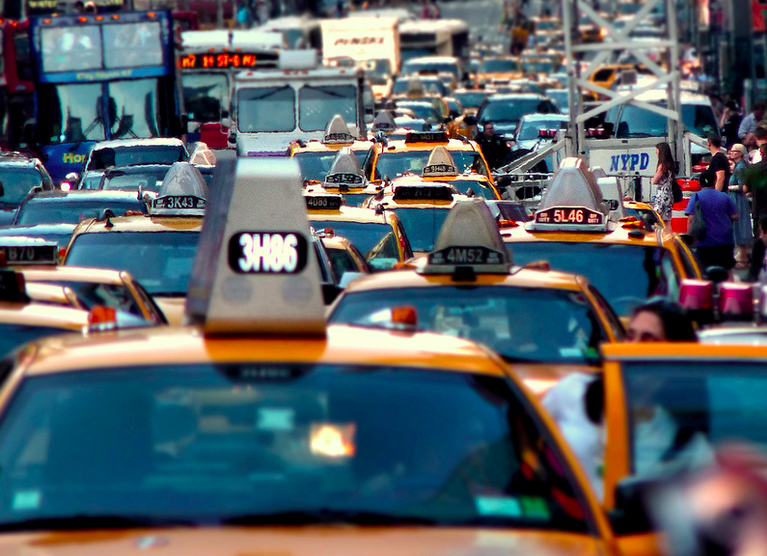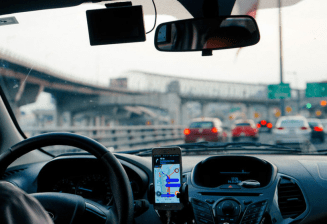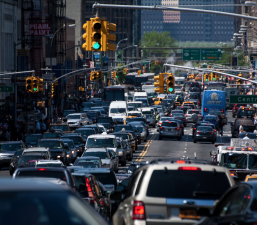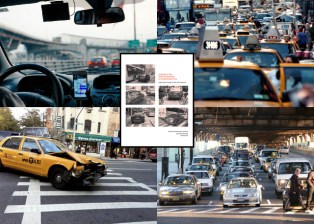KOMANOFF: Not So Fast — New Uber/Lyft Rules Will Speed Traffic Less Than City Thinks

New York City is going to “reign in congestion,” shouted Wednesday’s mayoral press release, heralding caps on Uber and Lyft cruising in the Manhattan taxi zone that will “increase speeds in the evening rush hour by up to 10 percent.”
Oops. The mayor presumably meant he’s going to “rein in” traffic congestion. But “reign in” is probably a closer fit.
By my modeling, de Blasio’s plan to extend the cap on the number of Ubers and Lyfts — and also cut their cruising time to 31 percent from the current 41 percent — will increase Manhattan travel speeds by 2.5 percent.
Manhattan gridlock is so endemic that even a 2.5 percent dent would register. But it’s a far cry from the mayor’s promised 10 percent.
Moreover, even that modest gain will hinge on critical but unannounced details: who will monitor the cruising time? Will the penalties for violating it be tough enough to force compliance? The prospect of monthly $1 million fines if Uber doesn’t lower its vehicles’ idle rates is the proverbial fly to an elephant: a mere 20 cents per ride in the taxi zone. Imagining that such mild penalties will induce Uber and Lyft to thin their presence in gridlocked Manhattan is whistling past the graveyard. (City officials say if the app-based companies don’t pay the fines, they’ll strip them of their licenses.)
I’ll have more to say about possible fines in a future post. For now, I’ll discuss my estimate that cutting Uber-Lyft’s cruising rate to 31 percent — a target to be met next summer — will raise Manhattan travel speeds by just 2.5 percent. (Spoiler alert: look for “the rebound effect,” by which clearing out street space without charging a congestion price invites other motorists to colonize that space.)
We begin, as always, with my BTA Excel spreadsheet, which you can download with this link (current version is from late May). From the “Motor Vs” tab, we see that Ubers and Lyfts currently account for an estimated 884,000 daily vehicle miles traveled in the Manhattan Central Business District, out of a total of 3,237,000 for all vehicles. (That’s in Row 118.)
City officials say that Ubers and Lyfts currently spend 41 percent of their time in the Manhattan taxi zone cruising, i.e. moving or stationary without a fare. As a shortcut while I write on deadline, I’m letting miles stand for minutes and ascribing 41 percent of Uber and Lyft’s total vehicle miles traveled to cruising. I also use the CBD as a proxy for the larger taxi zone up to 96th Street.
With a little algebra, the daily Uber and Lyft travel that must be jettisoned to cut the cruising rate to the mandated 31 percent is calculated to be 67,000 miles. (That’s calculated, before rounding, as the difference between one and 1.31/1.41, multiplied by 884,000.)
Here’s where the modeling gets tricky. Because the BTA is built to model congestion pricing rather than regulatory edicts such as cruising caps, I have to simulate the forced reduction in 67,000 daily miles of CBD travel as a drop in the number of private autos driven into the CBD. That number turns out to be 25,800 daily vehicle entries. When I input that reduction into the spreadsheet (using the “Baseline” scenario, and entering negative 25,800 into Cell E261 in the “Policy Levers” tab), the predicted gain in daytime CBD travel speeds (shown near the top of the “Results” tab) is — muffled drumroll — 2.5 percent.

Why is my 2.5 percent modeling result so much less than the mayor’s promised 10 percent? True, the press release did say “up to 10 percent.” But the difference is still elusive. Here are two possibilities:
One is that the mandated disappearance of 67,000 daily cruising miles amounts to just 2 percent of total CBD miles, that is, not much. And while it’s true that hyper-congestion is non-linear, with modest reductions in traffic often spawning big gains in travel speeds, there’s that rebound effect to contend with. With the BTA’s “time-elasticity” values, we can count on having to give back around a third of any mandated drop in Manhattan traffic to opportunistic trips popping up to take advantage of the higher speeds.
The bottom line, then — if, like me, you trust the BTA — is that the laudable plan to trim Uber and Lyft cruising rates by 10 percentage points will boost daytime Manhattan travel speeds by only 2 to 3 percent. And even that requires not just compliance by both app-based ride behemoths, but an absence of gaming as well.
For example, what’s to prevent Uber and Lyft from tweaking their driver-compensation algorithms to load the reductions in cruising rates on overnight hours, when the social and economic gains from reduced cruising are minimal?
There’s a far better way to address not just street congestion from Uber and Lyft, but also their predatory competition that has decimated the yellow cab sector: create a per-minute charge on Uber and Lyft when they are idle within the Manhattan taxi zone — a measure that would cut not only idle time rates per vehicle, but also the numbers of Ubers and Lyfts that hang out in the zone, period.
I’ve outlined that approach in previous posts (most notably, here, when I was, briefly, a consultant to a taxi-medallion owner). Watch this space for a fuller portrait.



